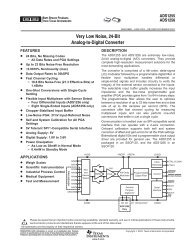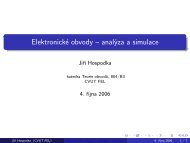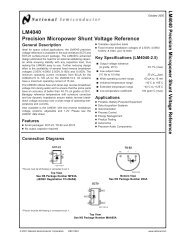LTC2410 24-Bit No Latency âΣTM ADC with Differential Input and ...
LTC2410 24-Bit No Latency âΣTM ADC with Differential Input and ...
LTC2410 24-Bit No Latency âΣTM ADC with Differential Input and ...
Create successful ePaper yourself
Turn your PDF publications into a flip-book with our unique Google optimized e-Paper software.
<strong>LTC<strong>24</strong>10</strong>APPLICATIO S I FOR26ATIOU W U UFor relatively small values of input capacitance (C IN 0.01µF) may berequired in certain configurations for antialiasing or generalinput signal filtering. Such capacitors will average theinput sampling charge <strong>and</strong> the external source resistancewill see a quasi constant input differential impedance.When F O = LOW (internal oscillator <strong>and</strong> 60Hz notch), thetypical differential input resistance is 1.8MΩ which willgenerate a gain error of approximately 0.28ppm for eachohm of source resistance driving IN + or IN – . When F O =HIGH (internal oscillator <strong>and</strong> 50Hz notch), the typicaldifferential input resistance is 2.16MΩ which will generatea gain error of approximately 0.23ppm for each ohm ofsource resistance driving IN + or IN – . When F O is driven byan external oscillator <strong>with</strong> a frequency f EOSC (externalconversion clock operation), the typical differential inputresistance is 0.28 • 10 12 /f EOSC Ω <strong>and</strong> each ohm ofsource resistance driving IN + or IN – will result in1.78 • 10 –6 • f EOSC ppm gain error. The effect of the sourceresistance on the two input pins is additive <strong>with</strong> respect tothis gain error. The typical +FS <strong>and</strong> –FS errors as a functionof the sum of the source resistance seen by IN + <strong>and</strong> IN – forlarge values of C IN are shown in Figures 19 <strong>and</strong> 20.In addition to this gain error, an offset error term may alsoappear. The offset error is proportional <strong>with</strong> the mismatchbetween the source impedance driving the two input pinsIN + <strong>and</strong> IN – <strong>and</strong> <strong>with</strong> the difference between the input <strong>and</strong>reference common mode voltages. While the input drivecircuit nonzero source impedance combined <strong>with</strong> theconverter average input current will not degrade the INLperformance, indirect distortion may result from the modulationof the offset error by the common mode componentof the input signal. Thus, when using large C IN capacitorvalues, it is advisable to carefully match the source impedanceseen by the IN + <strong>and</strong> IN – pins. When F O = LOW(internal oscillator <strong>and</strong> 60Hz notch), every 1Ω mismatchin source impedance transforms a full-scale commonmode input signal into a differential mode input signal of0.28ppm. When F O = HIGH (internal oscillator <strong>and</strong> 50Hznotch), every 1Ω mismatch in source impedance transformsa full-scale common mode input signal into adifferential mode input signal of 0.23ppm. When F O isdriven by an external oscillator <strong>with</strong> a frequency f EOSC ,every 1Ω mismatch in source impedance transforms afull-scale common mode input signal into a differentialmode input signal of 1.78 • 10 –6 • f EOSC ppm. Figure 21shows the typical offset error due to input common modevoltage for various values of source resistance imbalancebetween the IN + <strong>and</strong> IN – pins when large C IN values areused.If possible, it is desirable to operate <strong>with</strong> the input signalcommon mode voltage very close to the reference signalcommon mode voltage as is the case in the ratiometricmeasurement of a symmetric bridge. This configurationeliminates the offset error caused by mismatched sourceimpedances.The magnitude of the dynamic input current depends uponthe size of the very stable internal sampling capacitors <strong>and</strong>upon the accuracy of the converter sampling clock. Theaccuracy of the internal clock over the entire temperature<strong>and</strong> power supply range is typical better than 0.5%. Sucha specification can also be easily achieved by an externalclock. When relatively stable resistors (50ppm/°C) areused for the external source impedance seen by IN + <strong>and</strong>IN – , the expected drift of the dynamic current, offset <strong>and</strong>gain errors will be insignificant (about 1% of their respectivevalues over the entire temperature <strong>and</strong> voltage range).Even for the most stringent applications, a one-timecalibration operation may be sufficient.






